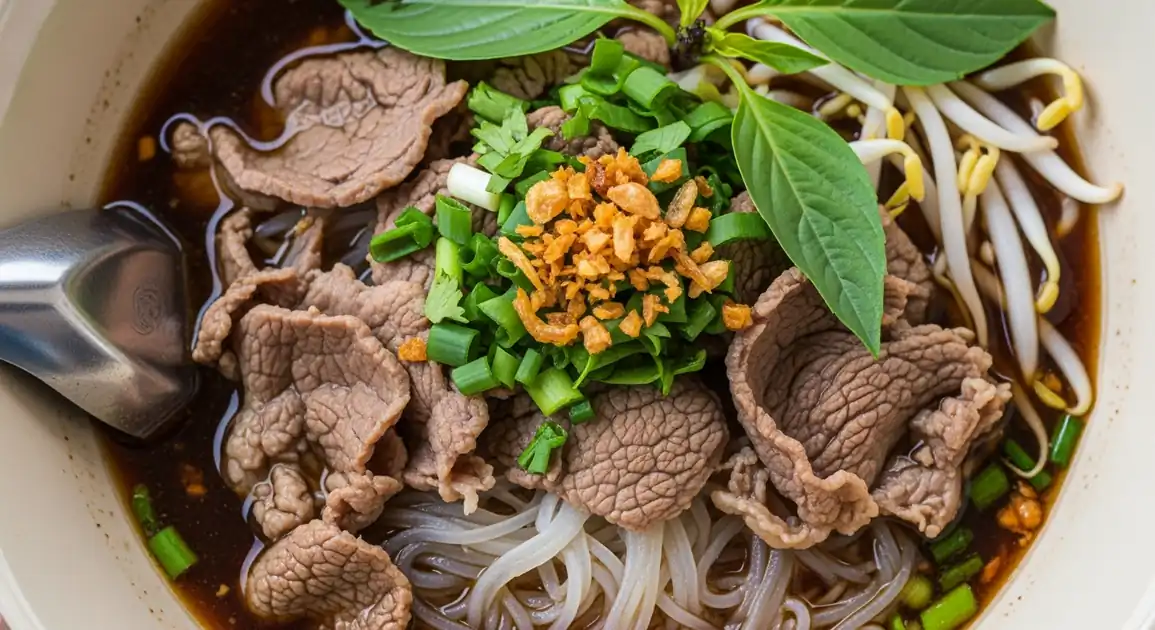Beef Noodle Soup
ก๋วยเตี๋ยวเนื้อ (Kuay Teow Neua)

Description
Beef noodle soup is widely available throughout Thailand, with regional variations reflecting local tastes and influences. Central Thai versions tend to have clearer broths with Chinese influences, while Northern variants might incorporate more local herbs. Found in street stalls, shophouses, and food courts nationwide, it's considered an everyday comfort food rather than a tourist attraction.
Dietary Information
Serving information
Serving style
Served in bowls with spoon and chopsticks. Table condiments typically include sugar, dried chili flakes, fish sauce, and vinegar with chilies for customization. Some vendors provide a small dish for bones and gristle.
Quick facts
Most street vendors operate from 7 AM - 2 PM or until sold out. Restaurant versions typically open longer, from 10 AM - 8 PM.
Safety Tips
What to Look For
-
Rapidly boiling broth at cooking station
The broth must be kept at a rolling boil to ensure safe cooking temperatures that kill potential pathogens, especially important for meat products.
-
Fresh meat stored properly (refrigerated or on ice)
Raw beef should be kept cold until cooking. Look for vendors who slice meat to order or keep it refrigerated/on ice rather than at ambient temperature.
-
Busy vendors with high customer turnover
Popular stalls with consistent customer flow ensure ingredients are used quickly and broth is replenished regularly, reducing food safety risks.
-
Separate utensils for raw and cooked ingredients
Vendors should use different tools for handling raw meat versus serving cooked food to prevent cross-contamination.
What to avoid
-
Pre-cooked meat sitting at ambient temperature
Cooked beef stored at room temperature for extended periods can harbor harmful bacteria. Meat should either be kept in hot broth or refrigerated.
-
Lukewarm or barely simmering broth
Broth that isn't hot enough won't properly cook raw ingredients or kill potential pathogens. Look for visibly boiling broth.
-
Dirty preparation surfaces or utensils
Unclean cutting boards, knives, or serving implements can introduce contaminants. Overall stall cleanliness is a good indicator of food safety practices.
-
Condiments with visible contamination or left uncovered
Table condiments exposed to flies or without covers can be sources of contamination. Look for covered containers and clean serving spoons.
Price information
Price range
Budget tips
- Street vendors typically offer the most affordable options (40-60 THB per bowl).
- Specify regular size (ธรรมดา 'tammada') rather than special/large (พิเศษ 'pi-set') to save money.
- Food court vendors in malls are usually mid-priced (60-80 THB).
- Specialized beef noodle restaurants can charge 80-120 THB, especially for premium beef cuts.
Value indicators
- Generous beef portions, including both lean meat and tender parts.
- Clear, aromatic broth with depth of flavor.
- Freshly cooked noodles with proper texture (not mushy).
- Complimentary herbs and bean sprouts that look fresh.
- Free refills of broth at some vendors.
Where to Find This Dish
Market Areas
Fresh markets often have noodle vendors along their periphery, benefiting from access to fresh ingredients.
Local fresh markets, Morning markets
Morning, Lunch
Commercial Districts
Business areas have numerous vendors catering to office workers seeking quick, filling meals.
Office buildings, Commercial centers
Lunch, Early evening
Transportation Hubs
Areas near bus terminals and train stations often have beef noodle vendors serving commuters.
Bus terminals, Train stations, Major intersections
Morning, Evening rush hour
Vendor Tips
- Vendors displaying their beef prominently (often hanging) typically take pride in their meat quality.
- Look for stalls with visible, clean broth pots at a rolling boil.
- Specialization is a good sign - vendors dedicated solely to beef noodles often perfect their recipe.
How to Order
Regional Variations
-
Regular Beef Noodle Soup
(ก๋วยเตี๋ยวเนื้อธรรมดา (Kuay Teow Neua Tammada))
The standard version with sliced beef and sometimes beef balls in a clear to light brown broth, typically served with rice noodles and bean sprouts.
-
Beef Boat Noodles
(ก๋วยเตี๋ยวเรือเนื้อ (Kuay Teow Reua Neua))
A specialized version with a darker, richer broth traditionally containing beef blood for thickness. Served in smaller bowls with more intense flavors, often featuring varied beef cuts including offal.
-
Braised Beef Noodle Soup
(ก๋วยเตี๋ยวเนื้อตุ๋น (Kuay Teow Neua Toon))
Features slow-cooked, tender chunks of braised beef rather than sliced meat. The broth is often darker and more concentrated from the braising process.
-
Dry Beef Noodles
(ก๋วยเตี๋ยวเนื้อแห้ง (Kuay Teow Neua Haeng))
Noodles tossed with seasoning sauce and topped with beef, served with little or no broth (usually provided in a separate small bowl for sipping).
-
Spicy Beef Noodle Soup
(ก๋วยเตี๋ยวเนื้อต้มยำ (Kuay Teow Neua Tom Yum))
A spicy variant where the beef broth is infused with tom yum flavors including lime, chili, and lemongrass for a tangy, spicy profile.
Cultural context
History
Beef noodle soup in Thailand represents the significant Chinese culinary influence, particularly from Teochew immigrants who brought noodle soup techniques in the late 18th and 19th centuries. The dish evolved by incorporating Thai flavors and local ingredients, becoming a staple of street food culture. Various regional styles developed, with Central Thailand versions featuring clearer broths and Bangkok vendors creating distinctive variations. The related 'boat noodles' originated from canal-based vendors in central Thailand who served concentrated, smaller portions from boats.
Local significance
Beef noodle soup represents the significant Chinese culinary influence in Thailand, particularly from Teochew immigrants. It's considered an everyday comfort food that crosses social boundaries, enjoyed by everyone from laborers to office workers.
Eating customs
- Use both spoon and chopsticks together - spoon in dominant hand, chopsticks in the other.
- Taste the broth first before adding condiments.
- Slurping noodles is acceptable and even considered appreciative.
- It's common to slightly lift the bowl toward the end for easier access.